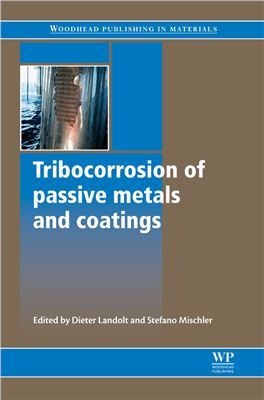Woodhead Publishing, 2011, 554 pages
Woodhead Publishing in Materials
Metals can become less reactive to corrosion processes (i.e. they become passive) because of protection by a self-healing surface film. This passivation process is an important weapon against corrosion in metals. However, the corrosion resistance of passive metals can be substantially reduced by friction and wear. This important book reviews current research on tribocorrosion of passive metals and coatings.
Fundamentals of tribocorrosion
Corrosion and passivity of metals and coatings
Adsorption layers and passive oxide films on metals
Friction and wear of passive metals and coatings
Environmental effects in fretting
Tribocorrosion mechanisms in sliding contacts
Models and mechanisms of erosion–corrosion in metals
Methods for measurement and prevention of tribocorrosion
Electrochemical methods in tribocorrosion
Tribocorrosion test protocols for sliding contacts
Methods for studying erosion–corrosion
Metallic materials for tribocorrosion systems
Coatings for tribocorrosion protection
Tribocorrosion in engineering and medicine
Biotribocorrosion: surface interactions in total joint replacement (TJR)
Tribocorrosion in artificial joints: in vitro testing and clinical implications
Fretting corrosion in biomedical implants
Tribocorrosion issues in nuclear power generation
Tribocorrosion in marine environments
Erosion-accelerated corrosion in flow systems: the behavior of aluminum alloys in automotive cooling systems
Chemical-mechanical polishing (CMP): a controlled tribocorrosion process
Tribocorrosion at elevated temperatures in the metal working industry
Woodhead Publishing in Materials
Metals can become less reactive to corrosion processes (i.e. they become passive) because of protection by a self-healing surface film. This passivation process is an important weapon against corrosion in metals. However, the corrosion resistance of passive metals can be substantially reduced by friction and wear. This important book reviews current research on tribocorrosion of passive metals and coatings.
Fundamentals of tribocorrosion
Corrosion and passivity of metals and coatings
Adsorption layers and passive oxide films on metals
Friction and wear of passive metals and coatings
Environmental effects in fretting
Tribocorrosion mechanisms in sliding contacts
Models and mechanisms of erosion–corrosion in metals
Methods for measurement and prevention of tribocorrosion
Electrochemical methods in tribocorrosion
Tribocorrosion test protocols for sliding contacts
Methods for studying erosion–corrosion
Metallic materials for tribocorrosion systems
Coatings for tribocorrosion protection
Tribocorrosion in engineering and medicine
Biotribocorrosion: surface interactions in total joint replacement (TJR)
Tribocorrosion in artificial joints: in vitro testing and clinical implications
Fretting corrosion in biomedical implants
Tribocorrosion issues in nuclear power generation
Tribocorrosion in marine environments
Erosion-accelerated corrosion in flow systems: the behavior of aluminum alloys in automotive cooling systems
Chemical-mechanical polishing (CMP): a controlled tribocorrosion process
Tribocorrosion at elevated temperatures in the metal working industry

